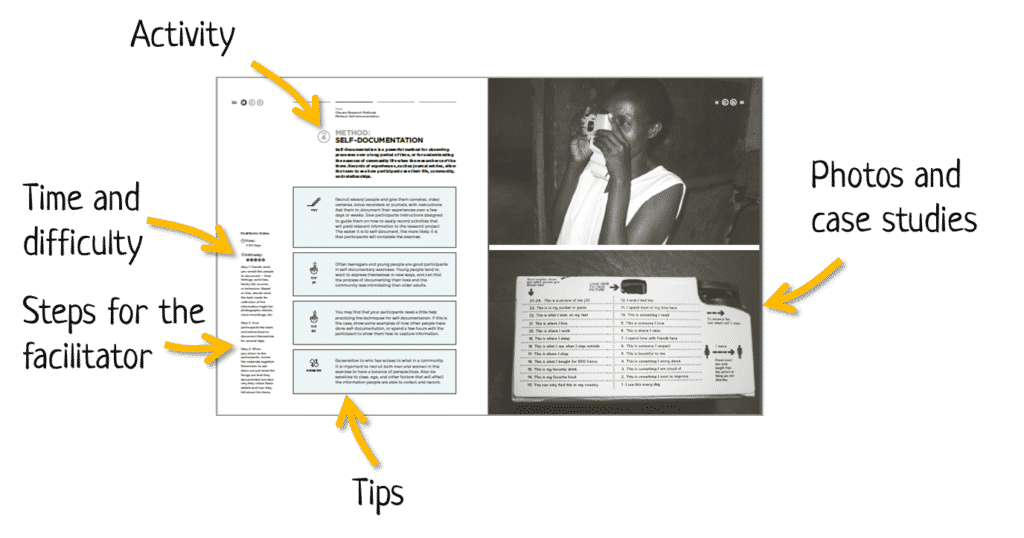Review Overview
Content - 80%
Ease of use - 70%
Usefulness - 90%
80%
A toolkit for designing new products, services and technologies for international development / aid.
Update: IDEO and +Acumen are partnering to offer a free online course on Human-Centered Design for Social Innovation
Last year I did a free design course from the University of Pennsylvania. The course wasn’t specifically for international development – most of the practical exercises were on designing a new type of ice-cream scoop.
But I soon realised that principles of good design are just as important for designing a new kitchen utensil as they are for designing a water filter or emergency shelter. Without a good process, it’s easy to end up with development failures like the LifeStraw.
Download the Human-Centered Design Toolkit
IDEO have taken this idea to the next level and created a Human-Centered Design (HCD) Toolkit for international development / aid. According to IDEO:
Human-Centered Design is a process and a set of techniques used to create new solutions for the world… The reason this process is called “human-centered” is because it starts with the people we are designing for.
How does it work?
The HCD Tookit can be used to design new products, services and technologies for international development / aid. There are three phases in the process:
- Hear: Collecting stories and inspiration from people using field research.
- Create: Turning what you heard from people into possible solutions.
- Deliver: Bringing your solutions into reality.
For each phase, the toolkit lists the steps that you should follow, and provides activities for each step. You don’t need to do all the steps or activities – just pick the ones that will work for you, as long as you do some from each phase.
The creators have estimated the time and difficulty level for each step / activity, and provided blank worksheets at the end of the toolkit. There are interesting photos and case studies throughout.
One activity from the HCD toolkit
What is it like to use in practice?
I tested the toolkit by using it to design a village clinic for children under 5 years old (part of the program that I am currently working on). I didn’t try all the steps or activities, but I did some from each phase, including activities with our team and with the community.
Here are a few examples of activities:
- (Hear) In-context immersion: Meeting people where they live, work, and socialise to fully experience the design challenge. In our case we shadowed the community health worker as they were treating children to understand what challenges they faced every day.
- (Create) Participatory co-design: Bring people from the community together to design solutions to a challenge. We asked the community to elect a committee for the village clinic design. Then we invited the committee members, chiefs and community health workers to brainstorm ideas together.
- (Deliver) Plan mini-pilots and iteration: For each solution in your pipeline plan mini-pilots before large-scale pilots or full-scale implementation to keep the idea alive. We piloted our idea by renting a house that was a similar design and location to the clinic we planned to build. This allowed us to see if the idea worked before construction started.
The toolkit itself is very nicely designed. I found the instructions easy to follow, and the activities worked well. The toolkit creators obviously have a lot of experience in community-based work so their tips are specific and helpful. For example, they recommend not wearing branded NGO t-shirts during group activities, and using a second team member to distract people who might listen in to an individual interview.
I was pleased to see they have specific recommendations on how to address gender issues throughout the process. They also have the same approach to interviews versus focus groups as tools4dev.
What are the limitations?
The toolkit can be a bit overwhelming for someone who is doing their first design project. There are 19 steps in three phases, and many different methods to choose from. Some of the language approaches buzzword territory (“participatory co-design”, “empathic design”) which can also be confusing.
The toolkit can be used to design a product (like a new water filter), a service (like a new HIV testing centre), or a technology (like an SMS reminder system). The benefit is that you can apply it to any type of problem. The downside is that the advice is fairly generic. It would be interesting to see different types of toolkits for physical products compared to services.
My one major concern is that the toolkit barely addresses the issue of whether your solution actually works. Evaluation of the final solution is tacked on at the end of the process, with only two activities (“tracking indicators” and “evaluating outcomes”). It is not addressed systematically throughout the design process. Treating the results as an afterthought is exactly the problem that Kevin Starr identified in his PopTech Talk on design failures in development.
The bottom line
The HCD Toolkit provides step-by-step instructions and activities for designing new products, services and technologies in international development / aid.
The HCD Toolkit is useful when:
- You want to design a new product, service or technology.
- You want to make sure the end users will be involved in the design process.
The HCD Toolkit is NOT useful when:
- You want to design a new program or policy. While HCD could be used for this purpose, it is more common to use approaches like problem tree analysis and theories of change.
Photo by Endre Vestvik





